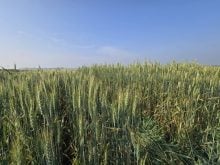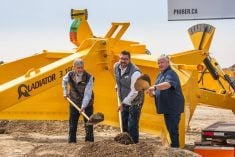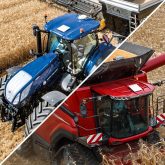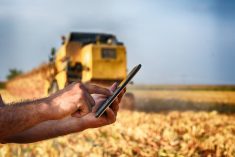Governments should incentivize farm digitalization like they incentivize environmental farm plans, Farmers’ Edge CEO Wade Barnes told participants in the Manitoba Protein Summit.
“The opportunity that comes out of it is just enormous,” he said.
Barnes took part in a panel discussion on digital innovation alongside other experts in farm technology during the virtual summit on February 23.
A focus on the farmer is critical when it comes to food sustainability, Barnes said. Once the food gets to the elevator and beyond, it’s easy to trace what happens to it.
“The biggest challenge that I think the supply chain has is the farmer himself,” he said.

In an interview with the Co-operator Barnes estimated that maybe 25 per cent of farm acres would have some kind of digitalization by the end of 2022. Digitalization, he said, means the ability to track and trace all aspects of a farm from tractor engine hours to planting rates and yields to weather data.
Data like this can enable the farmer to make better decisions — e.g. which varieties perform best on that farm under certain conditions and allows for more precise placement of inputs.
This is a next step from the Environmental Farm Plan (EFP), which was put in place to get a better understanding of the environmental impact of farms, said Barnes.
As an incentive to do an EFP, farmers were offered subsidies to buy precision ag or GPS equipment, Barnes said. The ability to apply inputs at variable rates created more efficient farms. Digitalization would allow changes and efficiencies to actually be logged and tracked, therefore proven.
Read Also

Journal pulls long-cited glyphosate study for ethics violations
The journal Regulatory Toxicology and Pharmacology has retracted a 2000 Monsanto-linked glyphosate review, drawing new scrutiny as Bayer faces mounting legal pressure.
This becomes important, for instance, if governments set fertilizer-reduction targets, Barnes told the Co-operator.
“The things that they (farmers) do on the farm probably are — they might not be reducing fertilizer by 30 per cent, but they’re probably 30 per cent more efficient than what they were doing before,” Barnes said. “They have no way to communicate that. The government has no way to measure this.”
Likewise, there’s no way to reward farmers for hitting targets without credible data and records.
Barnes suggested that farmers should be offered reduced insurance costs, or reduced lending costs through Farm Credit Canada if they digitalize. Or they should have a percentage of implementation cost covered.
For that investment, he predicts Canada would get a significant advantage among global buyers who want low-carbon-intensity grain.
Grain buyers need scale, he added. They need a large pool of low-carbon grain to fill orders.
“The countries that can move this faster will draw these opportunities to them sooner, because it’s about scale,” he said.
More data-driven decisions would create more climate-resilient farmers, said Barnes. This would mean fewer crop insurance claims, creating further value for the government. In turn, digital data could verify made claims.
For farmers, digitalized farms could create opportunities like carbon offsets and insets.
Barnes acknowledged that if governments subsidize farmers to implement digitalization, they will want some access to that data — e.g. for seeded acreage or yield surveys.
However, he told the Co-operator that many farmers are already supplying that data through crop insurance applications.















